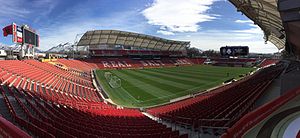Rio Tinto Stadium
| "The RioT" | |
 |
|
 |
|
| Address | 9256 South State Street |
|---|---|
| Location | Sandy, Utah |
| Coordinates | 40°34′59″N 111°53′35″W / 40.582923°N 111.893156°WCoordinates: 40°34′59″N 111°53′35″W / 40.582923°N 111.893156°W |
| Public transit | Sandy Expo (UTA station) |
| Owner | Dell Loy Hansen |
| Operator | Dell Loy Hansen |
| Capacity | 20,213 |
| Field size | 120 × 75 yards |
| Surface | Kentucky Bluegrass |
| Construction | |
| Broke ground | August 12, 2006 |
| Opened | October 9, 2008 |
| Construction cost |
$110 million ($122 million in 2017 dollars) |
| Architect | Rossetti Architects |
| Project manager | ICON Venue Group |
| Structural engineer | Martin & Associates |
| Services engineer | M-E Engineers, Inc. |
| General contractor | Layton-Turner Joint Venture |
| Tenants | |
|
Real Salt Lake (MLS) (2008–present) Real Monarchs SLC (USL) (2015–present) |
|
Rio Tinto Stadium (commonly referred to as simply Rio Tinto or "The RioT") is an American soccer-specific stadium in Sandy, Utah, that is the home to Major League Soccer club Real Salt Lake and its USL associate team, Real Monarchs SLC. The stadium opened on October 9, 2008, and seats 20,213 for soccer, but can be expanded to over 25,000 for concerts.
The stadium hosted the 2009 MLS All-Star Game, the second leg of the 2011 CONCACAF Champions League Finals, and the final of the 2013 Lamar Hunt US Open Cup. It was also a host stadium during the 2013 CONCACAF Gold Cup, and a host for final stages of the 2015 CONCACAF Men's Olympic Qualifying Championship.
In 2005 a soccer-specific stadium for the team was approved for Sandy, a suburb of Salt Lake City. However, funding for the stadium was still hard to come by. A vote in early 2006 struck down a funding proposal for the stadium. However, Tom Dolan, the mayor of Sandy, said that he would not give up on his fight to approve the proposal in Sandy. The funding plan was revised, but was struck down later in 2006 over disagreements in the appropriation of millions of hotel-tax dollars for a financially unproven sports franchise. The proposal for Sandy was declared "dead" by Real Salt Lake owner Dave Checketts at that point, putting the team's future in doubt. Checketts said that he wanted the team to remain in Utah, but would sell it if a proposal was not put forward by August 12, 2006.
Parties from several cities, including Rochester, New York and St. Louis, Missouri, expressed interest in purchasing the franchise and moving it. Other stadium sites in the area were also proposed, including the Utah State Fairgrounds in Salt Lake City, and the tiny town of Vineyard, just west of Provo. Finally, on the very day Checketts had set as a deadline to have a stadium plan in place or decide to sell the team, and after months of up and down discussions with local municipalities, county, and state officials and a change in the funding structure, a tacit agreement between Checketts, Sandy City, and Salt Lake County was put in place, and Real Salt Lake announced that they would move forward with the construction of Real Salt Lake Stadium, which would ultimately be named Rio Tinto Stadium. The groundbreaking, coinciding with the Xango Cup, Real's match against international power Real Madrid, took place that afternoon featuring elected leaders, team officials, as well as the entire rosters of both Real Salt Lake and Real Madrid. On August 15, the deal was officially approved by the Salt Lake County Council.
...
Wikipedia
